|
|
You are not currently logged in. Are you accessing the unsecure (http) portal? Click here to switch to the secure portal. |
Lulu booklist
Since Lulu doesn't support making custom book lists, I put together this list of transcriptions and translations and such available through the site. I'll update it as things come to my attention. Inclusion on this list is not an endorsement by Wiktenauer, merely a notice that these books exist.
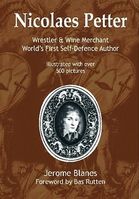 |
Nicolaes Petter, the Biography by Jerome Blanes Paperback The ultimate Nicolaes Petter source. Nicolaes Petter was a Wine Merchant and a well-known and undefeated Wrestler in Amsterdam during the 17th century. In 1674 his knowledge about wrestling and self-defence was published in a book with 71 etchings by the famous artist and illustrator Romeyn de Hooghe. According to many martial artists and historians, it is one of the most important martial arts books ever published. This book is the biography of Nicolaes Petter and an introduction to the world around him. Also describes 17th century Amsterdam, the Oude and Nieuwe Doolhof, Wine trade, Crime and violence, Lutherism in Amsterdam. Includes Petter's original books. Full training manual of: Petter's self defence suggestions, examples wrestling, weight lifting with barrels. Foreword by MMA legend and champion Bas Rutten. BIBLIOGRAPHY WITH SOURCES FROM PAGE 641. For more information: www.nicolaespetter.blogspot.com |
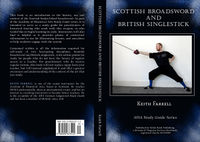 |
Scottish Broadsword and British Singlestick by Keith Farrell Paperback This book is an introduction to the history, use and context of the Scottish basket-hilted broadsword. As part of the Academy of Historical Arts Study Guide series, it is intended to serve as a study guide for practitioners of historical fencing who work with this weapon, or who would like to begin learning its style. Instructors will also find it helpful as it provides plenty of contextual information to use for illustrating lessons, and anecdotes to help students engage with the system. Contained within is all the information required for self-study of two fascinating disciplines, Scottish broadsword and British singlestick, with salient points for study for people who do not have the luxury of regular access to a teacher. For practitioners who do receive regular tuition, this book will not replace input from your teacher, but will instead supplement it and offer a greater awareness and understanding of the context of the art that you study. For more information and reviews: Scottish Broadsword and British Singlestick |
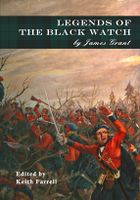 |
Legends of the Black Watch by Keith Farrell Paperback Ten years after the 1715 Jacobite uprising, General Wade came to the Highlands with the mission to pacify the clans and uphold the law. On the command of King George I, he raised six independent Highland Companies, which were known as the "Black Watch" or "Reicudan Dhu". Within half a century of its inception, the regiment had become well-known and respected for its bravery and skill at arms, and there were many stories of their valiant efforts in battle. Legends of the Black Watch, first published in 1859, recounts such stories vividly. The tales within this book show the bravery, leadership, and martial skill with which the soldiers and officers of the Black Watch faced their foes with musket and broadsword, as they fought throughout Europe and North America in the eighteenth and nineteenth centuries. The stories serve not only as a record of the legends of the regiment, but also show the mindset and beliefs of the Scottish people during this time period. The descriptions of battles and individual armed encounters will be of interest to students of European martial arts and historical fencing methods, and will be delightful to readers who seek riveting action scenes! For more information and reviews: Legends of the Black Watch |
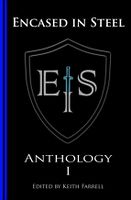 |
Encased in Steel Anthology I by Keith Farrell Paperback Celebrating four years of Encased in Steel. The writing team behind the Encased in Steel blog (Keith Farrell, Alex Bourdas and Ben Kerr, with guest author Benjamin Hawkins) have compiled some of the best articles from the last four years into the first Encased in Steel anthology. The articles have been edited heavily and updated significantly, to ensure a high quality of both scholarship and written language. Some new and unique articles have been written specifically for this volume, that are not available on the blog. The book is divided into five thematic parts, each dealing with a different element of the study of historical European martial arts. Topics include chivalry, history and research, studies of weapons, test cutting, and practical concerns. For more information and reviews: Encased in Steel Anthology I |
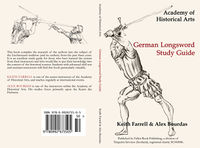 |
AHA German Longsword Study Guide by Keith Farrell and Alex Bourdas Paperback This book compiles the research into the subject of the Liechtenauer tradition (and its outliers) from the past three years. It is an excellent study guide for people who have learned the system from their instructors and who would like to put their knowledge into the context of the historical sources. Students with advanced skill sets and assistant instructors will find this book particularly valuable. For more information and reviews: AHA German Longsword Study Guide |
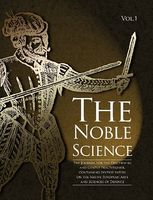 |
The Noble Science by Mark Hillyard Paperback: Volume 1 - Volume 2 The journal for the discerning and gentle practitioner. Containing diverse papers on the native European Arts and Sciences of Defence. |
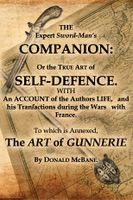 |
The Expert Sword-Man's Companion, 1728 by Ben Kerr Paperback A story so incredible, it was believed to be historical fiction. Donald McBane is a figure from history much loved by those who have had the joy of studying his autobiography. Growing up in Inverness and later joining the British regiments, McBane travelled across Europe pimping, duelling, blowing himself up, and performing other incredible feats of a not always admirable nature. The last we hear of him is when he comes out of his retirement in his fifties to fight one last bout in Edinburgh against an uppity Irish youngster, where he defeated his opponent and walked off with barely a scratch himself. Yet for all his heroic and sometimes crazy actions, he is remembered only for a single act of cowardice on maps marked as the "Soldier's Leap". This is a highly accurate reproduction of McBane's original work from 1728, created by the historian Ben Kerr. It features reproductions of all the original image plates as well as a full and accurate transcription of McBane's original text including his teaching on self-defence, an account of his life and adventures and the art of gunnerie. For more information and reviews: The Expert Sword-Man's Companion, 1728 |
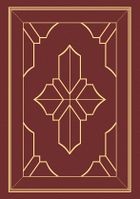 |
The Art of Defence on Foot, 1728 by Ben Kerr and Keith Farrell Paperback In 1798, Charles Roworth published his first edition of The Art of Defence on Foot with the Broadsword and Sabre, uniting the Scotch and Austrian methods into one Regular System. Although not a fencing master himself, Roworth's book provides an easy-to-follow system for a student of the broadsword or sabre. His instructions are clear and presume no prior knowledge of the sword; the book works well for beginners, yet even experienced swordsmen will benefit from Roworth's explanations of and rationales for techniques. This facsimile has been recreated from the original treatise owned by the Academy of Historical Arts in Glasgow. Each page has been photographed carefully and edited to provide an exacting reproduction of the highest quality. Additionally, the work includes a biography of Charles Roworth by Keith Farrell, and a brief essay by Ben Kerr on the Long-S character found within the original printed text. For more information and reviews: The Art of Defence on Foot, 1798 |
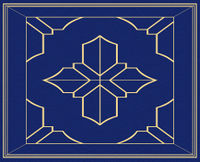 |
The Guards and Lessons of the Highland Broadsword, 1799 by Ben Kerr and Keith Farrell Paperback In 1798, Henry Angelo, a member of famed Angelo dynasty of sword masters, published Hungarian and Highland Broadsword, twenty-four plates designed by Thomas Rowlandson. This was a collection of 24 posters illustrating guards, defences and striking techniques for a man on foot or on horseback. In fact, only five of the 24 posters dealt with men on foot; the remaining 19 posters illustrated the use of the sword when mounted. The following year, in 1799, he published a poster called The Guards and Lessons of the Highland Broadsword, in which he set out his "10 lessons" (sometimes called the "10 divisions"), a set of sequences with which the Army regiments could drill and learn the system. This facsimile has been recreated from the collection of original posters owned by the Academy of Historical Arts in Glasgow. Each poster has been photographed carefully and edited to provide an exacting reproduction of the highest quality. The larger poster of 10 lessons has been provided in its original form, and also broken up to demonstrate the lessons on individual pages with higher resolution. Additionally, the work includes a brief biography by Keith Farrell describing the Angelo Dynasty, their schools and their publications. For more information and reviews: The Guards and Lessons of the Highland Broadsword, 1799 |
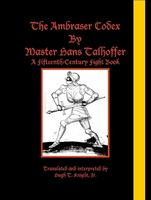 |
The Ambraser Codex by Master Hans Talhoffer by Hugh Knight Hardcover - Paperback Fight Master to the Stars! Hans Talhoffer was one the most famous and prolific of the 15th-century German fight masters with at least six fight books attributed to him that have survived to the present day. His Ambraser Codex from 1449 is one of the lesser-known fight books, but it contains a wealth of information about armored combat, dagger fighting, wrestling and mounted combat that makes it tremendously valuable to students of historical combat. Written for Talhoffer’s patron, Leutold von Königsegg, the Ambraser Codex gives us a fascinating blow-by-blow account of what judicial duels were like from start to finish. More than just a translation, the author has used other fighting manuals of the period to interpret Talhoffer’s techniques. This important book belongs on the shelves of everyone with an interest in the middle ages. Note: This is the perfect-bound edition. |
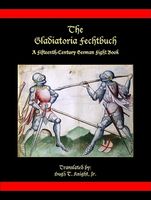 |
The Gladiatoria Fechtbuch by Hugh Knight Hardcover - Paperback This is the first-ever complete translation of the anonymous fifteenth-century fightbook commonly known as the Gladiatoria Fechtbuch. It contains detailed information on armored spear combat, halfsword combat, dagger combat, and ground fighting along with unarmored techniques for Long Shields, sword and buckler and staff combat. This book is a must have item for anyone with an interest in medieval combat or knighthood. Please Note: A few of the pictures in this book are of poor quality, however I have done what I could to clean these pictures and all of them are clear enough to interpret. I have made an effort to show some of the plates in the preview available here so that you, the customer, have a fair notion of what you're getting. |
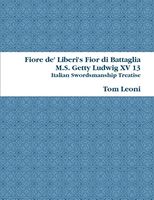 |
Fiore de' Liberi's Fior di Battaglia by Tom Leoni Paperback A revised edition has since been published through Freelance Academy Press. This book is the first English translation of Fiore de' Liberi's "Fior di Battaglia," the 1409 swordsmanship and martial arts text that is the oldest extant in the Italian tradition. The book survives in four known manuscripts. One of them, housed at the Getty museum in Los Angeles, CA, is held to be the most complete, and is the basis of this translation. Writing for an audience of illustrious students including the powerful marquis Nicolo' d' Este, Fiore presents detailed instruction on wrestling as well as the use of several weapons including longsword, axe, dagger, staff, lance and others. Fiore's text has been translated by experienced historical martial artist Tom Leoni of the Order of the Seven Hearts and reviewed by Maestro Sean Hayes of the Northwest Academy of Arms and by Greg Mele of the Chicago Swordplay Guild. Fourth revision. Text only. |
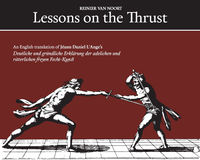 |
Lessons on the Thrust by Reinier van Noort Paperback In 1664, Jéann Daniel L'Ange published the Deutliche und gründliche Erklärung der adelichen und ritterlichen freyen Fecht-Kunst in Heidelberg, Germany. This was one of the first concise and systematic treatises on the typically German style of rapier fencing that evolved from the teachings of Fabris and his German students. L'Ange presents his personal point of view on this fencing style, which includes a rather large selection of brutal grappling moves. This first English translation of L'Ange's treatise, made by Reinier van Noort and published exactly 350 years after the original edition, provides a fascinating viewpoint on a fencing style that is underrepresented in the modern studies on historical martial arts. In this translation, Jéann Daniel L'Ange's view on fencing is presented in a way that is both close to the original, and clearly understandable by a modern reader. Meticulously cleaned scans of the 61 page size plates from the original treatise are also included. For more information and reviews: Lessons on the Thrust |
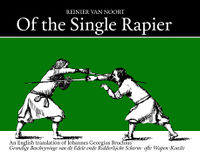 |
Of the Single Rapier by Reinier van Noort Paperback In 1671, Johannes Georgius Bruchius published the Grondige Beschryvinge van de Edele ende Ridderlijcke Scherm- ofte Wapen-Konste in Leiden, in the Netherlands. In his work, Bruchius described a style of rapier fencing that evolved from the teachings of Fabris. He presents this style through a brief explanation of the principles of fencing followed by 212 lessons. Bruchius' weapon was the rapier: a dangerous yet elegant sword of the 17th century. Its usage was dynamic and effective, with a focus on personal safety through controlling the opponent's blade. Not only does this treatise discuss bladework by way of thrusts and parries, Bruchius teaches grappling and disarming techniques, and provides many solutions to common problems that occur during fencing practice. Reinier van Noort first made a draft English translation of Bruchius' treatise available in 2009. In this new book, he presents his fully reworked and improved English translation of this important treatise, along with a detailed biographical study on the fencing master Bruchius. For more information and reviews: Of the Single Rapier |
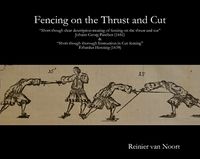 |
Fencing on the Thrust and Cut by Reinier van Noort Paperback Johann Georg Paschen (1628-1678) was a fencing master and prolific author in the 17th century, producing numerous treatises on for example fencing, fighting with the pike, and vaulting. Not much is known about Erhardus Henning, who published a small treatise on Cut-fencing in Königsberg in 1658. This book contains both these treatises, translated into English by Reinier van Noort, founder of the School voor Historische Schermkunsten in the Netherlands. In addition, photographs of the plates of Paschen are included with the text. |
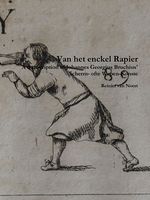 |
Transcription of Bruchius' Scherm- ofte Wapen-Konste by Reinier van Noort Hardback This is a full transcription of the Rapier fencing treatise written in Dutch by Johannes Georgius Bruchius, and published in Leiden in 1671. Additionally, this book contains black and white photo reproductions of all the plates contained in the original book. |
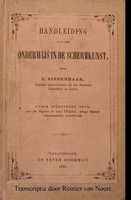 |
De Werken van Christiaan Siebenhaar by Reinier van Noort Hardcover This is a full transcription of the third edition of Christiaan Siebenhaar's "Handleiding voor het Onderwijs in de Schermkunst" (1861), which include photo reproductions of all plates included in the original. In addition, a full transcription of Christiaan Siebenhaar's "Wenken en Aanwijzingen voor den Onderwijzer in de Schermkunst" (1877) is included in this book. Please note that all text in this book is in Dutch. |
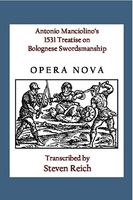 |
Antonio Manciolino by Steven Reich Paperback Published in 1531, this was the first treatise on swordsmanship published in the Italian language. Antonio Manciolino was a master of the Bolognese school of swordsmanship and his treatise covers nearly all of the classic weapons of that tradition, including the Assalti of sword and small buckler and the techniques for earnest swordsmanship for the sword and broad buckler or targa, sword and dagger, sword and rotella, sword and cape, sword-alone and two swords. In addition, Manciolino includes material for various polearms including the Partisan, Ronca, Spiedo, and Lance. |
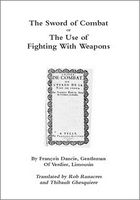 |
The Sword of Combat or The Use of Fighting With Weapons by Rob Runacres, Thibault Ghesquiere Paperback - eBook In the 17th century Italy was the place to learn the art of the sword. Travellers visited training salles and across Europe Italian works on fencing were translated and Italian schools sprang up. France was no exception. Francois Dancie’s 1623 treatise L’Espee de Combat (The Sword of Combat) is therefore an anomaly. Dancie’s views are blunt and acidic. He says that many who teach fencing are a ‘bunch of libertines’. He has no truck with the geometry that had crept into fencing since Agrippa’s work of 1553 and had contempt for that author’s use of illustration. Dancie’s style follows an Italian form, but rather than following other authors by providing an explanation of tempo and measure, Dancie prefers to concentrate on what temperament is required in a confrontation. His is a direct, fighter’s treatise, dedicated to a military man of similar temperament, his methods and descriptions speak more of the street than the salle. |
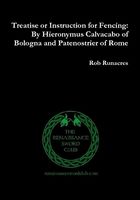 |
Treatise or Instruction for Fencing: By Hieronymus Calvacabo of Bologna and Patenostrier of Rome by Rob Runacres eBook In 1597 the great French traveller Seigneur de Villamont translated a fencing manuscript by his teacher, Girolamo (in French ‘Hieronyme’) Cavalcabo of Bologna, along with a shorter piece by Paternostrier of Rome. This treatise seems to have brought Cavalcabo to the attention of the French court and he, and later his son César, would be invited to teach the future Louis XIII. This treatise may represent survival of the great fencing tradition of Bologna, and could have influenced the development of French swordplay in the early seventeenth century. Now translated into English, this treatise offers an insight into the fighting style of the period. |
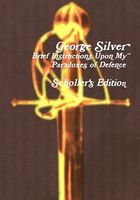 |
Brief Instructions Upon My Paradoxes of Defence: Scholler's Edition by George Silver Paperback George Silver’s ‘Brief Instructions Upon My Paradoxes of Defence’ is considered one of the foremost works in the Western martial arts canon. Conceived as a companion piece to his treatise ‘Paradoxes of Defence’ (1599); what is so remarkable is that from the start Silver explicitly sets out the theory and mechanics which underpin the Nobel Science of Defence. These principles are then illustrated through techniques for a wide range of weapons, including chapters on short sword, off hand grappling, sword and dagger, sword and buckler, two hand sword, staff, forest bill, pike and dagger fighting. This Scholler’s Edition has been designed with the new student in mind and accessibility as its primary concern. Silver’s language remains unaltered, but the spelling has been modernised and the work presented with a clear, contemporary layout accompanied by copious footnotes and supplementary material drawn from ‘Paradoxes of Defence’. The pocket-sized format makes this volume an invaluable training companion. |
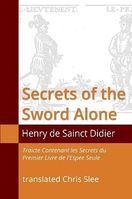 |
Secrets of the Sword Alone by Chris Slee Paperback A modern English translation of Henry de Sainct-Didier's 1573 fencing training manual. Sainct-Didier taught a style of swordsmanship informed by more than two decades as a soldier on the battlefields of France's Italian Wars. He demonstrates techniques which are straight forward and direct, without the niceties of the Italian and Spanish salles of the period. This is a textbook of lesson plans teaching basic cuts and thrusts, how to counter them, and the ways to respond to and defeat these defenses. It is written so that each action builds step by step into complex two-person drills in which initiative passes back and forth between the combatants. No interpretation of Sainct-Didier's text has been attempted, allowing his words to stand on their own merits. |
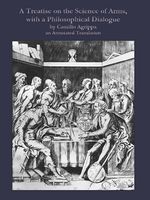 |
A Treatise on the Science of Arms, with a Philosophical Dialogue, by Camillo Agrippa: an Annotated Translation by Camillo Agrippa, W. Jherek Swanger Hardcover - Paperback Camillo Agrippa’s “Trattato di Scientia d’Arme, con un Dialogo di Filosofia”, published in 1553, is widely regarded as the seminal text of scientific fencing. Agrippa analyzed fencing in terms of geometry, biomechanics, and timing, laying the groundwork for centuries of fencing theory that followed him. This translation is thoroughly annotated, with a particular emphasis on aiding scholars and practitioners of historical fencing to follow Agrippa’s descriptions of combative sequences. An extensive introduction provides background on terminology, the author, and the text itself, places Agrippa’s system within the historical continuum of Italian fencing, and provides a thorough overview of the theoretical and technical aspects of the system. The latter part of the text, Agrippa’s “Philosophical Dialogue”, addresses various topics of geometry and pre-Copernican astronomy. Includes bibliography, appendices covering both the Treatise and Dialogue, and glossary. Please see the preview for sample pages |
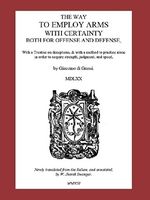 |
The Way to Employ Arms with Certainty by Giacomo di Grassi, W. Jherek Swanger Hardcover - Paperback Giacomo di Grassi’s “Ragione di adoprar sicuramente l'arme…” was originally published in 1570, discussing the use of the sword alone and with various companion weapons, as well as pole arms and the two-handed sword. Upon being translated and published with inferior illustrations in 1594 as “Giacomo di Grassi, His True Art of Defense…” it became the first text on swordplay to be published in English. Unfortunately, the Elizabethan English of the 1594 translation is not always easy on the modern reader, and, critically, suffers from inapt choices of terminology and numerous errors of translation. This wholly new translation has rectified these problems; it was made exclusively with reference to the original Italian text, rendering it into clear modern English, and reproduces the superior illustrations of the original. This translation renders di Grassi readily accessible, to the benefit of scholars, stage combat directors, and historical fencers alike. |
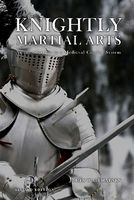 |
Knightly Martial Arts by James Wallhausen Paperback - eBook The noble knight in shining armour, emblazoned in brightly coloured surcoat, encased in polished metal and wielding deadly weapons is an evocative image. For the first time, the modern science of Combative Systemics has been combined with period resources to bring a comprehensive treatment of a Knightly Combat System, in an attempt to prove the eternal omnipotence of the knight’s martial arts. With this in mind, the author treats the medieval combat system within the context of reality-based fighting, including references from Wing Chun, Karate and Modern self-defence systems. Also included is a translation of the Long Sword and other parts of the HS.3227a manuscript - perhaps one of the most important documents of the German School. |
